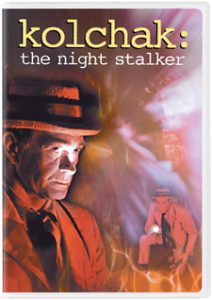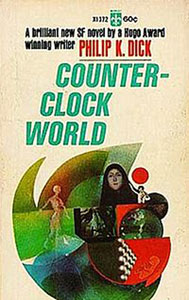“Counter-Clock World” (1967) starts with a healthy dose of vintage Philip K. Dick absurdism, as an old woman pleads to be freed from her coffin in a cemetery. In this future of 1998, aging (and some other things) go in reverse. And indeed, the sometimes delightful, sometimes over-the-top insanity of this world defines much of the novel.
Backdoor religious parallel
However, “Counter-Clock World” ends up being less about the world-building and more of a clever backdoor religious parable. It’s one of those PKD works that brings religion out of the realm of faith and misty history and into the realm of provable, witnessed events, while also commenting on societal forces that want to maintain the status quo, even if it means silencing the Good News.
But first, let’s talk about the rules of this world. The Hobart Phase has reversed the way time operates, so people are reborn from their coffins, among them main character Sebastian Hermes, who has fittingly gone into a career as a vitarium operator. Vitariums dig up the revived corpses, see that they are nursed back to health, and then sell the person to their family members or friends or – if necessary – the state.

“Counter-Clock World” (1967)
Author: Philip K. Dick
Genre: Science fiction
Setting: Los Angeles, future 1998
Whereas “The Curious Case of Benjamin Button” — the F. Scott Fitzgerald short story (1922) and David Fincher film (2008) – focuses on an individual aging backward, “Counter-Clock World” expands the scope to show a society where this is the normal state.
We get a little bit of Sebastian being haunted by his experience of waking up in his grave, and he notes how his multiple lifetimes of experience render him out of sync with his young wife, Lotta. (He also frets about how he is so much older than Lotta and can’t catch up to her youth. He is aging backward, but so is she, as the Hobart Phase strengthens to affect living people as well.)
Effect and cause
Weirdest of all are the processes that happen backward. Instead of eating food, people regurgitate it. Making it slightly less gross is the fact that it comes out intact and fresh, never having been chewed or digested.
Then the people return the components to their fridge and pantry, and eventually to the grocery store. Language has also changed to adjust to this reality: Greetings are “goodbye” and farewells are “hello.” The curse word “ass” has become “mouth,” and “shit” is now “food.” As a reader, I mainly laughed and shrugged off these reversed processes, customs and word meanings.
“Counter-Clock World” really clicks when PKD applies backwardness to institutions. The People’s Topical Library is the major villain. Its main purpose is to eradicate texts, employing Erads to do this work. People can still use the Library to seek knowledge, but they’ll be treated rudely if they try to do so. Also, instead of being among the lower-funded aspects of local government, the Library is a far-reaching political entity.

The Library is like something out of “1984.” Instead of writing a future, it erases the past, but the end result is similar: control of people’s perception of truth. Even though the processes are different – a prime gatekeeper (the Library) versus a multitude of them (social media) — modern readers might find “Counter-Clock World” has something to say about our struggles to decipher what is real and what is fake.
“Counter-Clock World” is somewhat stuck in its time – no pun intended — as the 1965 Watts riots in Los Angeles were foremost on PKD’s mind. He references them a few times, and structures his climactic showdown as a future version of the riots.
Geopolitical split
PKD extrapolates that the 1965 event led to a geopolitical split. Los Angeles is part of a mostly white nation called the Western United States, and blacks tend to live in the Free Negro Municipality; the author mentions that Kansas City is part of this nation. The novel broadly calls to mind the current Black Lives Matter movement, and the author’s split of America into white and black nations is poignant.
The book’s most pivotal old-born, the Anarch Peak, is part Martin Luther King Jr., part Gandhi, part Second Coming of Jesus Christ. At first, we suspect a conflict between the reborn Peak and the new leader of his Udi religion, Ray Roberts, who is a Malcolm X to Peak’s King. But Peak is such a powerful presence, not only as a human religious leader but also with his supernatural abilities to appear in people’s visions, that Roberts welcomes Peak’s return.
Although old-borns have been coming back for about a decade, Peak’s descriptions of being reborn are of particular interest to society because he’s so plugged in to religion to begin with. His desperate desire to get his thoughts recorded – and to see that they aren’t eradicated by the Library — could be read as a parallel to what Christ and his followers experienced 2,000 years ago. (I like that Peak is a down-to-Earth guy despite his status. He even has excellent relationship advice for Sebastian!)
PKD starts each chapter with a quote from a medieval religious philosopher about the nature of God, so there’s never any doubt that “Counter-Clock World” is exploring time as it exists outside the subjective linear impression that we perceive.
Indeed, PKD has tasked himself with not merely building an amusing world with its greetings of “goodbye,” but also one that readers’ minds will want to rebel against. While I still felt this world was weird as hell by the time I finished the book, I mostly grasped it, so that’s quite an accomplishment by the author right there.

